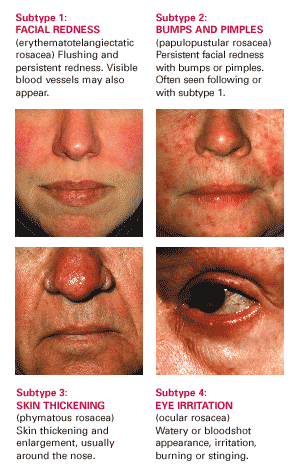Rosacea is a chronic skin condition that causes redness and swelling of the face that can also affect the scalp, neck, ears, chest, and back. Eye symptoms (ocular rosacea) are also reported by half of people with rosacea.
Those afflicted with rosacea may first notice a tendency to flush or blush easily. The condition progresses to persistent redness, pimples, and visible, threadlike blood vessels (telangiectasias) in the center of the face. These skin changes can eventually spread to the cheeks, forehead, chin, and nose.
Rosacea occurs most commonly in people 30 to 50 years of age. Although women have rosacea more commonly than men, men tend to suffer more severe forms.
Although rosacea’s cause remains unknown, it appears to involve a combination of genetics and environmental factors. It is not contagious.
Rosacea, also called acne rosacea, is different from the acne common in teenagers called acne vulgaris.
Symptoms & Signs
Even though rosacea afflicts an estimated 16 million people in the U.S., many are unaware that they have it. Signs and symptoms of rosacea include the following:
- A tendency to blush or flush easily
- Persistent redness in the center of the face
- Small visible blood vessels (telangiectasia)
- Bumps and pus-filled pimples on the face
- Burning or stinging sensation on the face; the skin also may itch or feel tight
- Dry skin on the face
- Swelling on the central face
- Eye problems, such as burning, itching, or watery eyes; swollen eyelids
- Thickening skin on the nose, cheeks, and/or forehead
- Rhinophyma—bumps on the nose that may develop if rosacea is left untreated
Early diagnosis and treatment of rosacea can control symptoms, alleviate discomfort, and stop rosacea from progressing.
Without proper treatment, rosacea tends to worsen and can become disfiguring. Signs that rosacea is worsening include increasing redness, pimples, and/or thickening skin.
What Are The Different Types Of Rosacea?
There are four subtypes of rosacea. People with rosacea have more than one rosacea subtype at the same time. Ocular rosacea may occur alone, with no changes to the skin.
- Subtype 1: Facial Redness (erythematotelangiectatic rosacea). Flushing and persistent redness. Visible blood vessels may also appear.
- Subtype 2: Bumps and Pimples (papulopustular rosacea). Persistent facial redness with bumps or pimples.
- Subtype 3: Skin Thickening (phymatous rosacea). Skin thickening and enlargement, usually around the nose.
- Subtype 4: Eye Irritation (ocular rosacea). Watery or bloodshot appearance, irritation, burning or stinging.

Courtesy of the National Rosacea Society
With treatment and lifestyle modifications, rosacea can be effectively controlled.
What Are Common Rosacea Treatments?
Although there is no cure for rosacea, a variety of safe and effective rosacea treatments are available to reduce its appearance and prevent further progression. If allowed to worsen over a long period, the symptoms of rosacea become more difficult to treat.
Rosacea treatments include oral and topical medications, lifestyle modifications, laser and light therapies, and surgical procedures (used mostly for advanced cases).
Your doctor will recommend a rosacea treatment plan based on the following:
- The rosacea subtype(s) you have developed
- The severity of rosacea
- Your skin type (light vs. dark, oily vs. dry)
- Results from previous treatments
- Your personal preferences
A combination of treatments may be recommended for optimal results. For instance, an oral medication, such as Oracea®,may be combined with a topical medication, such as Finacea®, or MetroGel®.
Prevention
There are a variety of skin care tips for rosacea that are helpful for avoiding rosacea flares. Patients should work with their doctors to establish a skin care regimen that includes the daily use of sunscreens, gentle cleansing, and the use of skin care products that don’t burn or sting.
Many people report that their rosacea flares up following exposure to certain triggers. Some common rosacea triggers include sun exposure, spicy foods, hot baths and emotional stress. A rosacea diary can be very useful for tracking rosacea symptoms over time and identifying possible triggers, so that they can be avoided.